[English] 日本語
 Yorodumi
Yorodumi- PDB-2lb3: Structure of the WW domain of PIN1 in complex with a human phosph... -
+ Open data
Open data
- Basic information
Basic information
| Entry | Database: PDB / ID: 2lb3 | ||||||
|---|---|---|---|---|---|---|---|
| Title | Structure of the WW domain of PIN1 in complex with a human phosphorylated Smad3 derived peptide | ||||||
 Components Components |
| ||||||
 Keywords Keywords | SIGNALING PROTEIN/TRANSCRIPTION / PIN1 / SMAD / CDK / signal transduction / SIGNALING PROTEIN-TRANSCRIPTION complex | ||||||
| Function / homology |  Function and homology information Function and homology informationzygotic specification of dorsal/ventral axis / homomeric SMAD protein complex / activin responsive factor complex / paraxial mesoderm morphogenesis / SMAD4 MH2 Domain Mutants in Cancer / SMAD2/3 MH2 Domain Mutants in Cancer / nodal signaling pathway / SMAD protein complex / endoderm formation / heteromeric SMAD protein complex ...zygotic specification of dorsal/ventral axis / homomeric SMAD protein complex / activin responsive factor complex / paraxial mesoderm morphogenesis / SMAD4 MH2 Domain Mutants in Cancer / SMAD2/3 MH2 Domain Mutants in Cancer / nodal signaling pathway / SMAD protein complex / endoderm formation / heteromeric SMAD protein complex / pericardium development / co-SMAD binding / determination of left/right asymmetry in lateral mesoderm / FOXO-mediated transcription of cell cycle genes / regulation of transforming growth factor beta receptor signaling pathway / secondary palate development / trophoblast cell migration / odontoblast differentiation / SMAD2/3 Phosphorylation Motif Mutants in Cancer / TGFBR1 KD Mutants in Cancer / Transcriptional regulation of pluripotent stem cells / embryonic foregut morphogenesis / Germ layer formation at gastrulation / cis-trans isomerase activity / primary miRNA processing / transforming growth factor beta receptor binding / phosphothreonine residue binding / pulmonary valve morphogenesis / SMAD protein signal transduction / Formation of definitive endoderm / type I transforming growth factor beta receptor binding / Signaling by Activin / embryonic cranial skeleton morphogenesis / activin receptor signaling pathway / Formation of axial mesoderm / positive regulation of BMP signaling pathway / Signaling by NODAL / response to cholesterol / negative regulation of cell motility / ubiquitin ligase activator activity / pancreas development / I-SMAD binding / regulation of protein localization to nucleus / GTPase activating protein binding / negative regulation of ossification / mitogen-activated protein kinase kinase binding / aortic valve morphogenesis / anterior/posterior pattern specification / ureteric bud development / insulin secretion / endocardial cushion morphogenesis / : / protein peptidyl-prolyl isomerization / organ growth / regulation of mitotic nuclear division / SMAD binding / negative regulation of SMAD protein signal transduction / PI5P Regulates TP53 Acetylation / negative regulation of amyloid-beta formation / R-SMAD binding / TGF-beta receptor signaling activates SMADs / cytoskeletal motor activity / mesoderm formation / negative regulation of cell differentiation / RHO GTPases Activate NADPH Oxidases / cell fate commitment / anatomical structure morphogenesis / phosphoserine residue binding / FOXO-mediated transcription of oxidative stress, metabolic and neuronal genes / positive regulation of epithelial to mesenchymal transition / postsynaptic cytosol / response to glucose / phosphatase binding / cis-regulatory region sequence-specific DNA binding / Rho protein signal transduction / negative regulation of protein binding / gastrulation / transforming growth factor beta receptor signaling pathway / lung development / Downregulation of TGF-beta receptor signaling / regulation of cytokinesis / post-embryonic development / peptidylprolyl isomerase / peptidyl-prolyl cis-trans isomerase activity / Negative regulators of DDX58/IFIH1 signaling / phosphoprotein binding / negative regulation of transforming growth factor beta receptor signaling pathway / Downregulation of SMAD2/3:SMAD4 transcriptional activity / SMAD2/SMAD3:SMAD4 heterotrimer regulates transcription / synapse organization / beta-catenin binding / negative regulation of protein catabolic process / regulation of protein stability / negative regulation of ERK1 and ERK2 cascade / ISG15 antiviral mechanism / tau protein binding / neuron differentiation / positive regulation of protein phosphorylation / disordered domain specific binding / positive regulation of canonical Wnt signaling pathway Similarity search - Function | ||||||
| Biological species |  Homo sapiens (human) Homo sapiens (human) | ||||||
| Method | SOLUTION NMR / simulated annealing | ||||||
| Model details | lowest energy, model 1 | ||||||
 Authors Authors | Macias, M.J. / Aragon, E. / Goerner, N. / Zaromytidou, A. / Xi, Q. / Escobedo, A. / Massague, J. | ||||||
 Citation Citation |  Journal: Genes Dev. / Year: 2011 Journal: Genes Dev. / Year: 2011Title: A Smad action turnover switch operated by WW domain readers of a phosphoserine code. Authors: Aragon, E. / Goerner, N. / Zaromytidou, A.I. / Xi, Q. / Escobedo, A. / Massague, J. / Macias, M.J. | ||||||
| History |
|
- Structure visualization
Structure visualization
| Structure viewer | Molecule:  Molmil Molmil Jmol/JSmol Jmol/JSmol |
|---|
- Downloads & links
Downloads & links
- Download
Download
| PDBx/mmCIF format |  2lb3.cif.gz 2lb3.cif.gz | 279.9 KB | Display |  PDBx/mmCIF format PDBx/mmCIF format |
|---|---|---|---|---|
| PDB format |  pdb2lb3.ent.gz pdb2lb3.ent.gz | 230.2 KB | Display |  PDB format PDB format |
| PDBx/mmJSON format |  2lb3.json.gz 2lb3.json.gz | Tree view |  PDBx/mmJSON format PDBx/mmJSON format | |
| Others |  Other downloads Other downloads |
-Validation report
| Summary document |  2lb3_validation.pdf.gz 2lb3_validation.pdf.gz | 404.4 KB | Display |  wwPDB validaton report wwPDB validaton report |
|---|---|---|---|---|
| Full document |  2lb3_full_validation.pdf.gz 2lb3_full_validation.pdf.gz | 558.2 KB | Display | |
| Data in XML |  2lb3_validation.xml.gz 2lb3_validation.xml.gz | 27.1 KB | Display | |
| Data in CIF |  2lb3_validation.cif.gz 2lb3_validation.cif.gz | 41.4 KB | Display | |
| Arichive directory |  https://data.pdbj.org/pub/pdb/validation_reports/lb/2lb3 https://data.pdbj.org/pub/pdb/validation_reports/lb/2lb3 ftp://data.pdbj.org/pub/pdb/validation_reports/lb/2lb3 ftp://data.pdbj.org/pub/pdb/validation_reports/lb/2lb3 | HTTPS FTP |
-Related structure data
| Related structure data |  2lajC  2lawC  2laxC  2layC  2lazC  2lb0C  2lb1C  2lb2C C: citing same article ( |
|---|---|
| Similar structure data | |
| Other databases |
- Links
Links
- Assembly
Assembly
| Deposited unit | 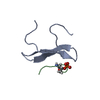
| |||||||||
|---|---|---|---|---|---|---|---|---|---|---|
| 1 |
| |||||||||
| NMR ensembles |
|
- Components
Components
| #1: Protein/peptide | Mass: 4231.692 Da / Num. of mol.: 1 / Fragment: residues 6-41 Source method: isolated from a genetically manipulated source Source: (gene. exp.)  Homo sapiens (human) / Gene: PIN1 / Production host: Homo sapiens (human) / Gene: PIN1 / Production host:  |
|---|---|
| #2: Protein/peptide | Mass: 886.882 Da / Num. of mol.: 1 / Fragment: residues 176-183 / Source method: obtained synthetically / Source: (synth.)  Homo sapiens (human) / References: UniProt: Q15796 Homo sapiens (human) / References: UniProt: Q15796 |
| Has protein modification | Y |
-Experimental details
-Experiment
| Experiment | Method: SOLUTION NMR Details: Structure of the first domain of human PIN1 in complex with a human Smad3 derived peptide( resi 173-186). | ||||||||||||||||||||||||
|---|---|---|---|---|---|---|---|---|---|---|---|---|---|---|---|---|---|---|---|---|---|---|---|---|---|
| NMR experiment |
|
- Sample preparation
Sample preparation
| Details |
| ||||||||||||||||||||||||||||||||||||||||||||||||||||||||||||||||
|---|---|---|---|---|---|---|---|---|---|---|---|---|---|---|---|---|---|---|---|---|---|---|---|---|---|---|---|---|---|---|---|---|---|---|---|---|---|---|---|---|---|---|---|---|---|---|---|---|---|---|---|---|---|---|---|---|---|---|---|---|---|---|---|---|---|
| Sample |
| ||||||||||||||||||||||||||||||||||||||||||||||||||||||||||||||||
| Sample conditions | Ionic strength: 0.42 / pH: 7 / Pressure: ambient / Temperature: 285 K |
-NMR measurement
| NMR spectrometer | Type: Bruker DRX / Manufacturer: Bruker / Model: DRX / Field strength: 600 MHz |
|---|
- Processing
Processing
| NMR software |
| ||||||||||||||||||||||||
|---|---|---|---|---|---|---|---|---|---|---|---|---|---|---|---|---|---|---|---|---|---|---|---|---|---|
| Refinement | Method: simulated annealing / Software ordinal: 1 | ||||||||||||||||||||||||
| NMR constraints | NOE constraints total: 557 / NOE intraresidue total count: 0 / NOE long range total count: 215 / NOE medium range total count: 56 / NOE sequential total count: 167 / Hydrogen bond constraints total count: 10 | ||||||||||||||||||||||||
| NMR representative | Selection criteria: lowest energy | ||||||||||||||||||||||||
| NMR ensemble | Conformer selection criteria: structures with acceptable covalent geometry Conformers calculated total number: 300 / Conformers submitted total number: 20 |
 Movie
Movie Controller
Controller


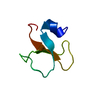
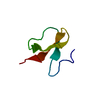

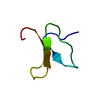

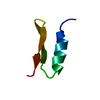
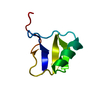
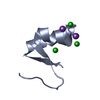

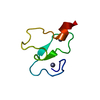
 PDBj
PDBj




















 HSQC
HSQC